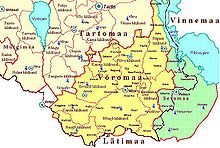Võro language
| Võro | |
|---|---|
| võro kiil | |
| Native to | Estonia |
| Region | Southern Estonia |
| Ethnicity | Võros |
|
Native speakers
|
87,000, including Seto (2011 census) |
|
Uralic
|
|
| Dialects | |
| Official status | |
| Regulated by | Võro Institute (semi-official) |
| Language codes | |
| ISO 639-3 | |
| Glottolog | None |

Võro language area — Võromaa (Võro county) in its historical boundaries between Tartu and Seto areas, Russia (Vinnemaa) and Latvia (Lätimaa)
|
|
The Võro language (Võro: võro kiil' [ˈvɤro kʲiːlʲ], Estonian: võru keel) is a language belonging to the Finnic branch of the Uralic languages. Traditionally it has been considered a dialect of the South Estonian dialect group of the Estonian language, but nowadays it has its own literary language and is in search of official recognition as an regional language of Estonia. Võro has 74,499 speakers (Võros) mostly in south-eastern Estonia, in the eight parishes of historical Võru County: Karula, Harglõ, Urvastõ, Rõugõ, Kanepi, Põlva, Räpinä, and Vahtsõliina. These parishes are currently centered (due to redistricting) in Võru and Põlva counties with parts extending into Valga and Tartu counties. Speakers can also be found in the towns of Tallinn, Tartu and the rest of Estonia.
Võro is a descendant of the old South Estonian regional language and is the least influenced by Standard Estonian (which is based on Northern Estonian dialects). Võro was once spoken further south and east of historical Võromaa in South Estonian-speaking enclaves Lutsi, Leivu and Kraasna in what is now Latvia and Russia. In addition to Võro, other contemporary variants of South Estonian include the Mulgi, Tartu and Seto dialect.
...
Wikipedia
